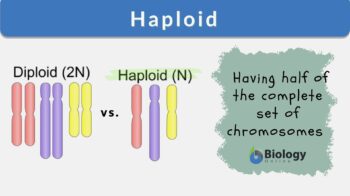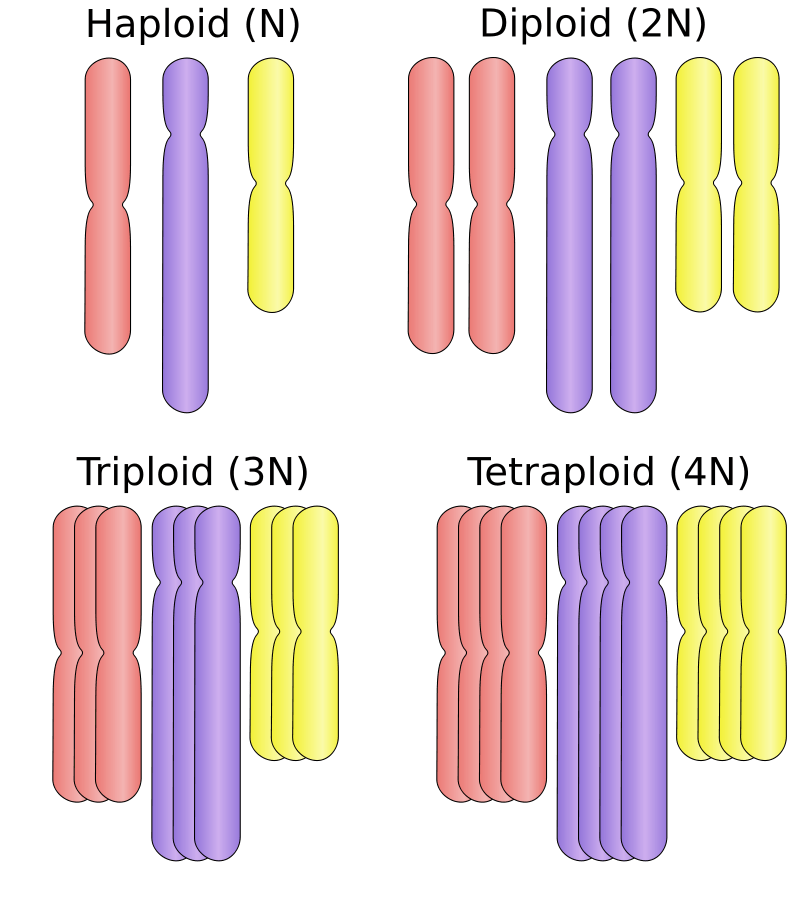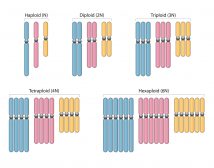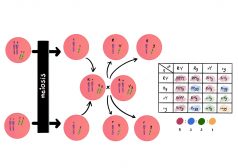
Haploid
n. or adj.
[ˈhæplɔɪd]
Definition: (Of a cell, an organism, or a condition) Having half of the usual complete set of chromosomes
Table of Contents
In biology, haploid pertains to a condition, a cell, or an organism that has half of the usual complete set of chromosomes in somatic cells. Haploidy refers to this specific condition. It is just one of the many types pertaining to ploidy. Other terms are monoploid (having only one set), diploid (having two sets), polyploid (three or more sets), such as triploid (with three sets), tetraploid (with four sets), and so on.
Haploid Definition
The word haploid describes a condition, a cell, or an organism that contains half of the set of homologous chromosomes present in the somatic cell. Homologous chromosomes are two chromosomes that pair up by having the same gene sequence, loci, chromosomal length, and centromere location. Half of the homologous pairs are maternal (coming from the mother) whereas the other half, paternal (coming from the father). Thus, in other words, a haploid is when a cell, for instance, contains half of the total homologous chromosomes, i.e. a single set of chromosomes that are unpaired.

Etymology
The term haploid came from Greek haplous, meaning single. The words haploidic and haploidy are derived words. Their definitions are based on the meaning of haploid. For instance, the word haploidic is used to pertain to a cell or an organism having half of the set of homologous chromosomes. Thus, haploidic may be used as a synonym for haploid when the latter is used as an adjective. As a noun, the term haploid refers to a cell (e.g. germ cell) or an organism (e.g. fungi) that is haploid. The term haploidy is also a noun. It specifically refers to the condition characterized by being haploid. Synonyms: haploidic. Compare: monoploid, diploid, polyploid.
Haploid vs. Other Ploidies

Ploidy refers to the number of sets of homologous chromosomes in the genome of a cell or an organism. Each set is designated by n. The term haploidy refers to the state of having half of the set of chromosomes. Haploid cells (e.g. gametes) are given a symbol n to indicate that they have only half of the chromosomal set of a somatic cell, i.e. any of the cells in the body of a multicellular organism but excluding the germ cells and the sex cells. In humans, somatic cells possess two sets of chromosomes. Thus, a human somatic cell would be a diploid cell and is designated with a symbol (2n). As for haploid and monoploid, the two terms are sometimes used interchangeably. This is when the term haploid is defined not as having half of a set but as having a single copy of the chromosomes in a cell; monoploid is defined the same way. When there are multiple sets present in a cell, the condition is described as polyploid. Special types of polyploids include triploid (3n), tetraploid (4n), pentaploid (5n), etc.
Examples of Haploid
Haploid cell in humans
Sex cells (gametes) are examples of haploid cells. In humans (as well as other higher forms of living things), the somatic cell contains two copies of genes. As such, they are referred to as diploids. They produce haploid gametes through gametogenesis, a process that makes use of meiosis that halves the chromosomal set. This is essential so that during the union of gametes the resulting zygote is diploid. This preserves the integrity of chromosomal number throughout generations.
In particular, the human sex cells (a sperm or an egg cell) will have 23 chromosomes. This means that the sperm cell and the egg cell contain only half the diploid number of a human somatic cell (which is 46). At fertilization, the two cells unite forming a zygote with now two sets of chromosomes. The human zygote, then, grows by going through mitosis. As a result, the archetypal chromosomal number of 46 in humans per somatic cell in the human body is maintained.
Plant gametophyte
Plants have a life cycle comprised of two generations: the gametophyte and the sporophyte. The gametophyte is a phase of a plant life cycle or the plant itself that bears the gametes. Thus, a gametophyte is a haploid multicellular form of the plant, e.g. the embryophytes.
See Also:
- Chromosomes
- Ploidy
- Fertilization
- Somatic cell
- Gamete
Further Reading:
- Meiosis – The Genetics of Reproduction – Biology Online Tutorial
References:
- CELL DIVISION: Meiosis. (2020). Retrieved from Estrellamountain.edu website: https://www2.estrellamountain.edu/faculty/farabee/biobk/BioBookmeiosis.html
- Haploid. (2020). Retrieved from Genome.gov website: https://www.genome.gov/genetics-glossary/haploid
© Biology Online. Content provided and moderated by Biology Online Editors








